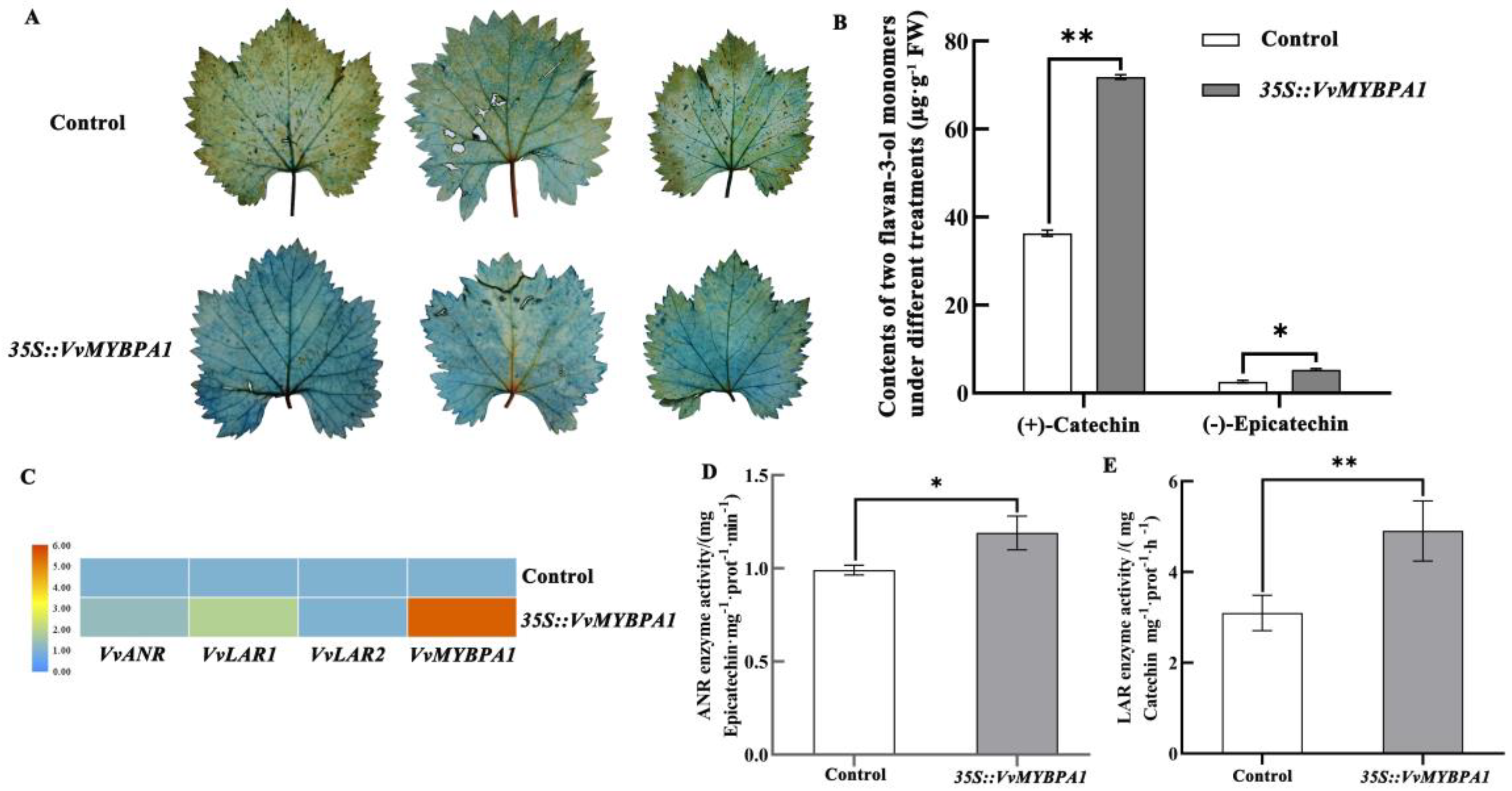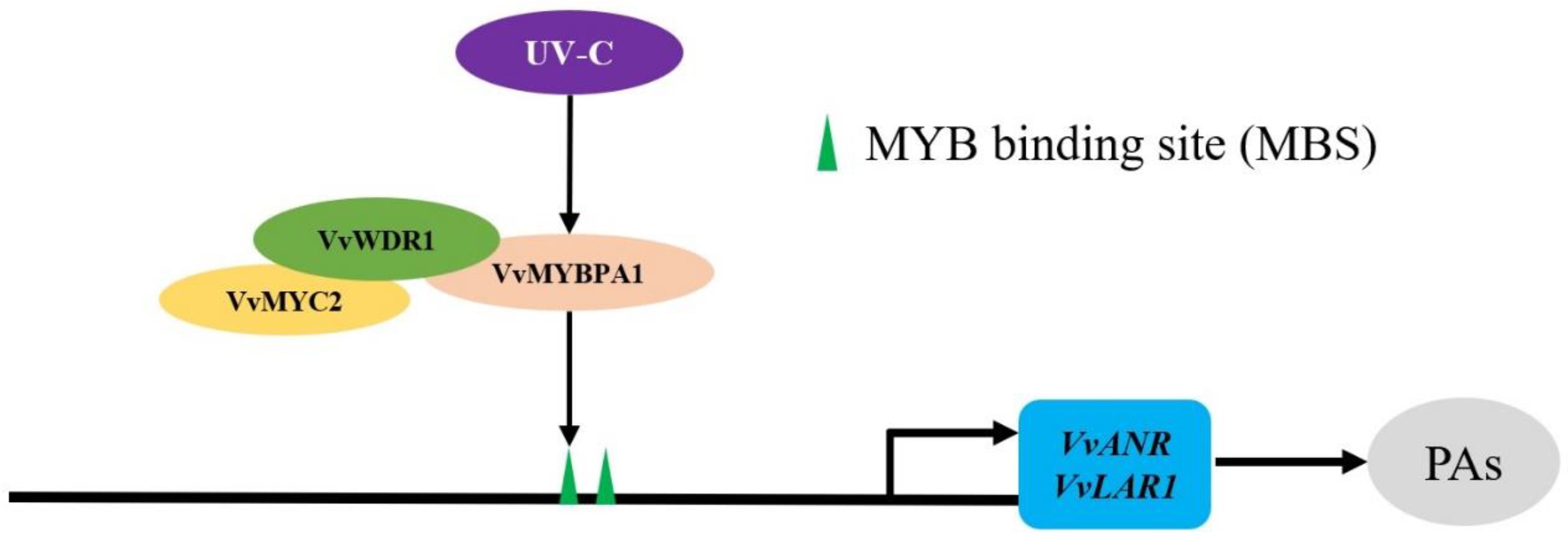UV-C Promotes the Accumulation of Flavane-3-ols in Juvenile Fruit of Grape through Positive Regulating VvMYBPA1
Abstract
:1. Introduction
2. Results
2.1. UV-C Led to the Accumulation of Flavane-3-ol Monomers in Juvenile Fruit of Grape
2.2. Characteristic Analysis of Transcription Factor VvMYBPA1
2.3. Instantaneous Overexpression of VvMYBPA1 Led to the Accumulation of Total Flavane-3-ols in Grape Leaves
2.4. VvMYBPA1 Formed a Trimer Complex with MYC2 through WDR1
2.5. VvMYBPA1 Could Be Directly Combined with the Promoters of VvLAR and VvANR
3. Discussion
4. Materials and Methods
4.1. Plant Materials
4.2. Grape Fruits at Different Stages Treated with UV-C
4.3. Instantaneous Overexpression in Grape Leaves
4.4. Fluorescence Quantitative Analysis
4.5. Subcellular Localization
4.6. DMACA Staining
4.7. Content Determination of (−)-Epicatechin and (+)-Catechin
4.8. LAR and ANR Enzyme Activity Determination
4.9. Yeast One Hybrid
4.10. Yeast Two Hybrid
4.11. Bimolecular Fluorescence Complementation
4.12. Data Processing
5. Conclusions
Supplementary Materials
Author Contributions
Funding
Institutional Review Board Statement
Informed Consent Statement
Data Availability Statement
Acknowledgments
Conflicts of Interest
References
- Dixon, R.A. Engineering of plant natural product pathways. Curr. Opin. Plant Biol. 2005, 8, 329–336. [Google Scholar] [CrossRef] [PubMed]
- Wen, P.F.; Ji, W.; Gao, M.Y.; Niu, T.Q.; Xing, Y.F.; Niu, X.Y. Accumulation of flavanols and expression of leucoanthocyanidin reductase induced by postharvest UV-C irradiation in grape berry. Genet. Mol. Res. 2015, 14, 7687–7695. [Google Scholar] [CrossRef] [PubMed]
- Colmenares, N.G.; Ramírez-Martínez, J.R.; Aldana, J.O.; Ramos-Niño, M.E.; Clifford, M.N.; Pékerar, S.; Méndez, B. Isolation, characterisation and determination of biological activity of coffee proanthocyanidins. J. Sci. Food Agric. 1998, 77, 368–372. [Google Scholar] [CrossRef]
- Liu, M.Y.; Song, C.Z.; Ming, C.; Wang, T.M.; Zuo, L.L.; Li, X.L.; Zhang, Z.W.; Xi, Z.M. The effects of light and ethylene and their interaction on the regulation of proanthocyanidin and anthocyanin synthesis in the skins of Vitis vinifera berries. Plant Growth Regul. 2016, 79, 377–390. [Google Scholar] [CrossRef]
- Zhao, S.; Zhu, Y.; Liu, W.; Wang, X.; Wang, H.; Cao, Y.; Chen, F.; Hu, L.; Gong, L.; Fu, C.; et al. Exogenous proanthocyanidins improve tolerance of Cu-toxicity by amelioration of oxidative damage and re-programming of gene expression in Medicago sativa. PLoS ONE 2021, 16, e0259100. [Google Scholar] [CrossRef]
- Charles, M.T.; Benhamou, N.; Arul, J. Physiological basis of UV-C induced resistance to Botrytis cinerea in tomato fruit III. Ultrastructural modifications and their impact on fiangal colonization. Postharvest Biol. Technol. 2008, 47, 27–40. [Google Scholar] [CrossRef]
- Charles, M.T.; Benhamou, N.; Arul, J. Physiological basis of UV-C induced resistance to Botrytis cinerea in tomato fruit IV. Biochemical modification of structural barriers. Postharvest Biol. Technol. 2008, 47, 41–53. [Google Scholar] [CrossRef]
- Jiang, J.; Xi, H.; Dai, Z.; Lecourieux, F.; Yuan, L.; Liu, X.; Patra, B.; Wei, Y.; Li, S.; Wang, L. VvWRKY8 represses stilbene synthase gene through direct interaction with VvMYB14 to control resveratrol biosynthesis in grapevine. J. Exp. Bot. 2018, 70, 715–729. [Google Scholar] [CrossRef]
- Niu, T.Q.; Li, C.; Yang, B.; Zhang, P.F.; Fan, W.; Wen, P.F. Characterization, expression and function analysis of anthocyanidin reductase gene from Vitis vinifera L. cv. Cabernet Sauvignon under UV-C irradiation. Biotechnol. Biotechnol. Equip. 2021, 35, 43–52. [Google Scholar] [CrossRef]
- Xi, H.F.; Ma, L.; Liu, G.T.; Wang, N.; Wang, J.F.; Wang, L. Transcriptomic analysis of grape (Vitis vinifera L.) Leaves after exposure to ultraviolet C irradiation. PLoS ONE 2014, 9, e113772. [Google Scholar] [CrossRef]
- Tanner, G.J.; Francki, K.T.; Abrahams, S.; Watson, J.M.; Larkin, P.J.; Ashton, A.R. Proanthocyanidin biosynthesis in plants. Purification of legume leucoanthocyanidin reductase and molecular cloning of its cDNA. J. Biol. Chem. 2003, 278, 31647–31656. [Google Scholar] [CrossRef] [PubMed]
- An, X.H.; Tian, Y.; Chen, K.Q.; Liu, X.J.; Liu, D.D.; Xie, X.B.; Cheng, C.G.; Cong, P.H.; Hao, Y.J. MdMYB9 and MdMYB11 are involved in the regulation of the JA-induced biosynthesis of anthocyanin and proanthocyanidin in apples. Plant Cell Physiol. 2015, 56, 650–662. [Google Scholar] [CrossRef] [PubMed]
- James, A.M.; Ma, D.; Mellway, R.; Gesell, A.; Yoshida, K.; Walker, V.; Tran, L.; Stewart, D.; Reichelt, M.; Suvanto, J.; et al. Poplar MYB115 and MYB134 transcription factors regulate proanthocyanidin synthesis and structure. Plant Physiol. 2017, 174, 154–171. [Google Scholar] [CrossRef] [PubMed]
- Li, J.; Luan, Q.; Han, J.; Zhang, C.; Liu, M.; Ren, Z. CsMYB60 directly and indirectly activates structural genes to promote the biosynthesis of flavonols and proanthocyanidins in cucumber. Hortic. Res. 2020, 7, 103–118. [Google Scholar] [CrossRef]
- Yang, S.; Zhang, M.; Xu, L.; Luo, Z.; Zhang, Q. MiR858b inhibits proanthocyanidin accumulation by the repression of DkMYB19 and DkMYB20 in persimmon. Front. Plant Sci. 2020, 11, 576378. [Google Scholar] [CrossRef]
- Bogs, J.; Jaffé, F.W.; Takos, A.M.; Walker, A.R.; Robinson, S.P. The grapevine transcription factor VvMYBPA1 regulates proanthocyanidin synthesis during fruit development. Plant Physiol. 2007, 143, 1347–1361. [Google Scholar] [CrossRef]
- Broun, P. Transcriptional control of flavonoid biosynthesis: A complex network of conserved regulators involved in multiple aspects of differentiation in Arabidopsis. Curr. Opin. Plant Biol. 2005, 8, 272–279. [Google Scholar] [CrossRef]
- Gonzalez, A.; Brown, M.; Hatlestad, G.; Akhavan, N.; Smith, T.; Hembd, A.; Moore, J.; Montes, D.; Mosley, T.; Resendez, J.; et al. TTG2 controls the developmental regulation of seed coat tannins in Arabidopsis by regulating vacuolar transport steps in the proanthocyanidin pathway. Dev. Biol. 2016, 419, 54–63. [Google Scholar] [CrossRef]
- Gil-Muñoz, F.; Sánchez-Navarro, J.A.; Besada, C.; Salvador, A.; Badenes, M.L.; Naval, M.D.M.; Ríos, G. MBW complexes impinge on anthocyanidin reductase gene regulation for proanthocyanidin biosynthesis in persimmon fruit. Sci. Rep. 2020, 10, 3543. [Google Scholar] [CrossRef] [PubMed]
- Schaart, J.G.; Dubos, C.; Romero De La Fuente, I.; van Houwelingen, A.M.M.L.; de Vos, R.C.H.; Jonker, H.H.; Xu, W.; Routaboul, J.M.; Lepiniec, L.; Bovy, A.G. Identification and characterization of MYB-bHLH-WD40 regulatory complexes controlling proanthocyanidin biosynthesis in strawberry (Fragaria × ananassa) fruits. New Phytol. 2013, 197, 454–467. [Google Scholar] [CrossRef]
- Xie, S.; Qiao, X.; Chen, H.; Nan, H.; Zhang, Z. Coordinated regulation of grape berry flesh color by transcriptional activators and repressors. J. Agric. Food Chem. 2019, 67, 11815–11824. [Google Scholar] [CrossRef] [PubMed]
- Amato, A.; Cavallini, E.; Zenoni, S.; Finezzo, L.; Begheldo, M.; Ruperti, B.; Tornielli, G.B. A Grapevine TTG2-Like WRKY Transcription Factor Is Involved in Regulating Vacuolar Transport and Flavonoid Biosynthesis. Front. Plant Sci. 2017, 7, 1979. [Google Scholar] [CrossRef] [PubMed]
- Wen, P.F.; Niu, X.Y.; Xing, Y.F.; Niu, T.Q.; Gao, M.Y.; Ji, Z.C. The Effect of UV-C Irradiation on Spatial and Temporal Accumulation of Flavanols and the Activity, Tissue Localization of LAR in Grape Berry. Acta Hortic. Sin. 2013, 40, 1251–1261. [Google Scholar]
- Liang, C.; Guo, J.; Chen, M.; Zhang, X.; Zhang, G.; Zhang, P. VvMYBPA2 Regulated the Accumulation of Flavan-3-ols though Forming a Trimeric Complex in ‘Zaoheibao’ Grape. Agriculture 2022, 12, 1414. [Google Scholar] [CrossRef]
- Liang, C.M.; Yang, B.; Wei, Y.; Zhang, P.F.; Wen, P.F. SA incubation induced accumulation of flavan-3-ols through activated VvANR expression in grape leaves. Sci. Hortic. 2021, 287, 110269. [Google Scholar] [CrossRef]
- Passeri1, V.; Martens, S.; Carvalho, E.; Bianchet, C.; Damiani, F.; Paolocci, F. The R2R3MYB VvMYBPA1 from grape reprograms the phenylpropanoid pathway in tobacco flowers. Planta 2017, 246, 185–199. [Google Scholar] [CrossRef]
- Baudry, A.; Heim, M.A.; Dubreucq, B.; Caboche, M.; Weussgaar, B.; Lepiniec, L. TT2, TT8, and TTG1 synergistically specify the expression of BANYULS and proanthocyanidin biosynthesis in Arabidopsis thaliana. Plant J. 2004, 39, 366–380. [Google Scholar] [CrossRef]
- Liu, Y.; Ma, K.; Qi, Y.; Lv, G.; Ren, X.; Liu, Z.; Ma, F. Transcriptional Regulation of Anthocyanin Synthesis by MYB-bHLH-WDR Complexes in Kiwifruit (Actinidia chinensis). J. Agric. Food Chem. 2021, 69, 3677–3691. [Google Scholar] [CrossRef]
- Zhao, L.; Song, Z.; Wang, B.; Gao, Y.; Shi, J.; Sui, X.; Chen, X.; Zhang, Y.; Li, Y. R2R3-MYB transcription factor NtMYB330 regulates proanthocyanidin biosynthesis and seed germination in tobacco (Nicotiana tabacum L.). Front. Plant Sci. 2022, 12, 819247–819261. [Google Scholar] [CrossRef]
- Zhang, F.; Gonzalez, A.; Zhao, M.; Payne, C.T.; Lloyd, A. A network of redundant bHLH proteins functions in all TTG1-dependent pathways of Arabidopsis. Development 2003, 130, 4859. [Google Scholar] [CrossRef]
- Li, X.; Liu, J.; Chang, Q.; Zhou, Z.; Han, R.; Liang, Z. Antioxidant and antidiabetic activity of proanthocyanidins from Fagopyrum dibotrys. Molecules 2021, 26, 2417–2438. [Google Scholar] [CrossRef] [PubMed]
- Kazuya, K.; Mineyo, N.; Ikuko, N.; Goto-Yamamoto, N.; Matsumura, H.; Tanaka, N. Functional characterization of a new grapevine MYB transcription factor and regulation of proanthocyanidin biosynthesis in grapes. J. Expt. Bot. 2014, 65, 4433–4449. [Google Scholar] [CrossRef]
- Li, Y.G.; Tanner, G.; Larkin, P. The DMACA-HCl Protocol and the Threshold Proanthocyanidin Content for Bloat Safety in Forage Legumes. J. Sci. Food Agric. 1996, 70, 89–101. [Google Scholar] [CrossRef]





Disclaimer/Publisher’s Note: The statements, opinions and data contained in all publications are solely those of the individual author(s) and contributor(s) and not of MDPI and/or the editor(s). MDPI and/or the editor(s) disclaim responsibility for any injury to people or property resulting from any ideas, methods, instructions or products referred to in the content. |
© 2023 by the authors. Licensee MDPI, Basel, Switzerland. This article is an open access article distributed under the terms and conditions of the Creative Commons Attribution (CC BY) license (https://creativecommons.org/licenses/by/4.0/).
Share and Cite
Liang, J.; Guo, J.; Liu, Y.; Zhang, Z.; Zhou, R.; Zhang, P.; Liang, C.; Wen, P. UV-C Promotes the Accumulation of Flavane-3-ols in Juvenile Fruit of Grape through Positive Regulating VvMYBPA1. Plants 2023, 12, 1691. https://doi.org/10.3390/plants12081691
Liang J, Guo J, Liu Y, Zhang Z, Zhou R, Zhang P, Liang C, Wen P. UV-C Promotes the Accumulation of Flavane-3-ols in Juvenile Fruit of Grape through Positive Regulating VvMYBPA1. Plants. 2023; 12(8):1691. https://doi.org/10.3390/plants12081691
Chicago/Turabian StyleLiang, Jinjun, Jianyong Guo, Yafei Liu, Zening Zhang, Runtian Zhou, Pengfei Zhang, Changmei Liang, and Pengfei Wen. 2023. "UV-C Promotes the Accumulation of Flavane-3-ols in Juvenile Fruit of Grape through Positive Regulating VvMYBPA1" Plants 12, no. 8: 1691. https://doi.org/10.3390/plants12081691




